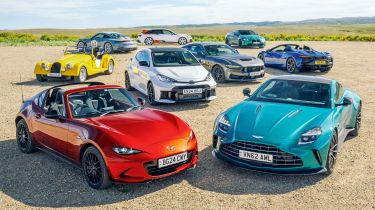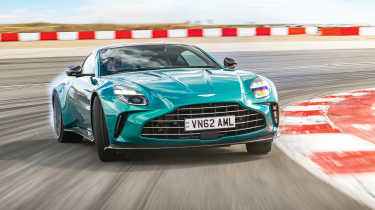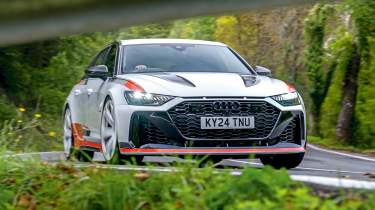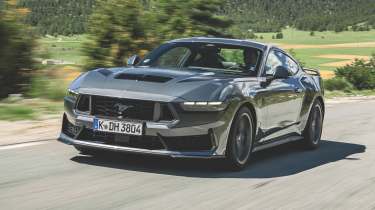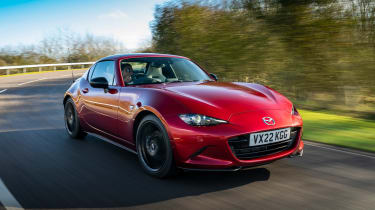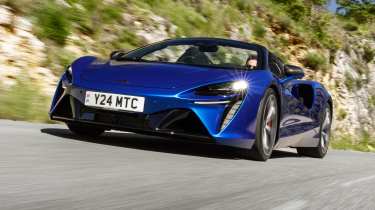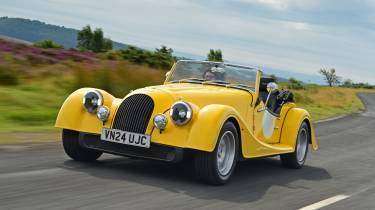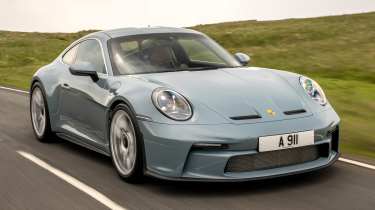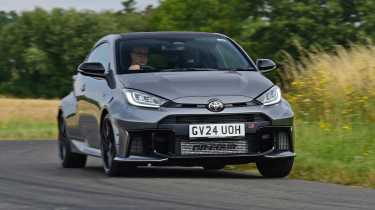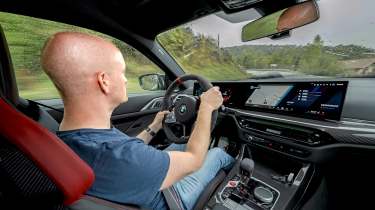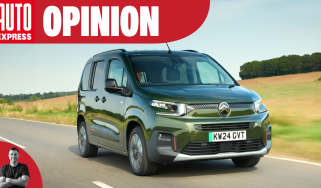Best driver's car 2025: Aston Martin Vanquish, McLaren Artura Spider, Porsche 911 S/T and more go head-to-head
We put 2024's finest sports cars and supercars through their paces to determine the best driver's car of them all
Wherever you look these days, digital tech is encroaching on our lives. Online banking, fridges that order food when supplies are low, AI solutions that can magically erase a gurning tourist from an otherwise lovely holiday selfie… it’s endless. And while much of it is useful, some is genuinely baffling.
As with most things, a fairly balanced approach is needed. Go all out on tech and it can seem heavy handed; ignore it altogether and you can be left behind.
The same applies to cars. There are lots of new machines with clever electric powertrains that can cater for everyday motoring very well, but often come at the expense of thrills. However, there’s also the potential for a smarter, more subtle approach, which not only maintains the level of fun we have come to expect from performance cars, but even enhances it.
So with tech foremost in our thoughts, we brought together nine of the finest performance cars to test over five days. First, we put them through their paces on the challenging roads of northern Spain, winding up from Pamplona towards the Pyrenees mountains, where we were greeted by a staggering ever-changing backdrop that continued as we crossed into France. Then, to test each car to its limits, we went to the Circuito de Navarra to find out how they perform on track.
Used - available now

2020 Volvo
XC40
38,459 milesAutomaticPetrol2.0L
Cash £20,226
2020 Suzuki
Ignis
6,188 milesManualPetrol1.2L
Cash £10,667
2024 Skoda
Superb
75,962 milesAutomaticPetrol2.0L
Cash £14,650
2023 Mercedes
CLA
17,468 milesAutomaticDiesel2.0L
Cash £23,911Which of these great cars finally emerged victorious? Read on to find out.
Aston Martin Vantage
AMG-powered Brit’s beauty goes more than skin deep, offering three cars in one
| Model: | Aston Martin Vantage |
| Price: | £165,000 |
| Engine: | 4.0-litre V8 twin-turbo petrol |
| Transmission: | Eight-speed auto, RWD |
| Power: | 656bhp/800Nm |
| 0-62mph: | 3.5 secs |
| Top speed: | 202mph |
| Fuel economy: | 23.9mpg |
| CO2 emissions: | 274g/km |
| Kerb weight: | 1,605kg |
We have certain assumptions about the way that a modern Aston Martin should drive. Graceful styling implies there should be a bit of refinement and class, but those smart suits are draped over muscular shapes which offer a subtle hint that the car might just be ready for a bit of a fist fight, too.
While some recent Astons haven’t quite lived up to our (very high) expectations, it takes little time spent with the new Vantage to confirm that it really hits the spot. It’s absolutely stunning, and the good news is that the drive matches up to the looks.
We think the Vantage looks best from the rear quarter angle, but what’s clear is that it’s even better in the metal than it is in photos. The Aston Martin Racing Green paint, the same shade used by the team’s Formula One cars (and the safety car), looks spectacular in the late summer light of the Pyrenees.
Once you’ve gawped at the exterior for long enough, then it’s time to settle into the similarly dramatic cabin. The raised centre console makes you feel cocooned in a clearly driver-focused environment, and the high dashboard line limits forward visibility somewhat – almost adding a layer of intimidation to the car’s character.
Prod that big starter button ahead of the gear selector, and the 4.0-litre twin-turbo V8 growls into life. While it’s based on a Mercedes-AMG unit, it sounds better here than in any of the German brand’s current offerings, with a menacing burble that turns into a full-bodied roar at the red line. Thank Aston Martin-specific tuning for that.
The resulting 656bhp and 800Nm means that the Vantage isn’t exactly a slouch, either. That peak torque figure runs from 2,750rpm right through to 6,000rpm, so regardless of the revs, your right foot can deliver a forward surge that widens the eyes and tightens the grip on the steering wheel. Such is the strength of the V8, you’ll need to be careful not to overwhelm the rear tyres as you squeeze your right foot to the floor. But fortunately, with so little lag, it’s possible to extract just the right amount of power.
With all this bravado from the engine, you might expect this to be a point-and-squirt sort of car. And in some ways, it is. Through a corner the rack weighs up appreciably, so you feel like you’re having to wrestle the car into behaving how you want it to. But once you’ve got on top of it, the Vantage rewards with surprising precision. The nose is very pointy and has incredible grip, so for all the muscle car charm, it feels quite light on its feet.
Even so, it does the grand tourer stuff as well as you’d hope, too. With the adaptive dampers in their most relaxed setting, there’s a noticeable difference, with the car giving a relaxing ride. The huge reserves of torque and wide stance make it a superbly long-legged continent-crosser. While some recent Astons have felt a little confused about whether they’re a GT car, a muscle car or a supercar, the Vantage gets closer to delivering on all fronts than any of its predecessors.
Audi RS 6 Avant GT
A 621bhp V8 and a 548-litre boot make a real multi-tasker
| Model: | Audi RS 6 Avant GT |
| Price: | £177,115 |
| Engine: | 4.0-litre V8 twin-turbo petrol |
| Transmission: | Eight-speed auto, 4WD |
| Power: | 621bhp/850Nm |
| 0-62mph: | 3.3 secs |
| Top speed: | 190mph |
| Fuel economy: | 23.0mpg |
| CO2 emissions: | 283g/km |
| Kerb weight: | 2,075kg |
If subtlety is your thing, then look away now. Nothing on this test attracted attention like the Audi RS 6 GT, whose decals and white wheels, barely containing some huge carbon brakes, give it spectacular presence.
There are more subdued black and grey exterior finishes with black graphics, but if we were one of the lucky 60 UK buyers, we’d have gone the whole hog and stuck with the white.
This run-out edition is more than just a stickers special, though. The wheelarches are even more flared than on the standard RS 6, and like the bonnet they are made from carbon fibre to shave a little weight. There’s a set of fantastic carbon bucket seats, too, and the low-slung driving position feels more like a big coupé than a five metre-long wagon.
But the most intriguing changes are under the skin. In place of the standard RS 6’s adaptive damping, the GT gets adjustable coilover suspension mated to stiffer springs and thicker anti-roll bars. And while the engine is unchanged over the regular RS 6, the way the V8’s might is transferred to the road has been adjusted courtesy of a revised rear differential and an updated centre diff. Four-wheel steering is also standard.
Those suspension changes made us initially worry that the Audi might feel a little too punishing on the road, but our concerns disappeared after a few metres. As is the case with the best suspension set-ups, those trick coilovers have an uncanny knack of rounding off bumps rather than crashing through them, and this suppleness gives the driver real confidence to explore the RS 6’s limits.
And those limits are staggering. A normal RS 6 is loaded with grip, but the GT adds incredible agility into the equation. The four-wheel-steering set-up feels very quick – almost unnaturally so at first – but this huge estate shows staggering responses in direction changes and phenomenal traction out of corners. Indeed, the Avant can be thrown around with the sort of abandon that left us looking over our shoulder to check that we hadn’t hopped into an RS 3.
But rather than the hatch’s five-pot sound, there’s a V8 bellow. Performance is as searing as the 3.2-second 0-62mph time suggests, but being able to deploy that performance effectively is most telling. If there’s a criticism, it’s that the Audi is so capable that sometimes you want more feedback and involvement. On the flip side, it’s a superbly refined cruiser, and nothing else here comes close to its practicality.
Audi has played a blinder, even with a steep £60k premium over a regular RS 6.
BMW M4 CS
Spectacular coupé is thrilling – until the weather turns
| Model: | BMW M4 CS |
| Price: | £120,345 |
| Engine: | 3.0-litre 6cyl twin-turbo petrol |
| Transmission: | Eight-speed auto, 4WD |
| Power: | 542bhp/560Nm |
| 0-62mph: | 3.4 secs |
| Top speed: | 188mph |
| Fuel economy: | 27.7mpg |
| CO2 emissions: | 232g/km |
| Kerb weight: | 1,835kg |
BMW’S M division has been fairly unpredictable lately. Occasionally it delivers something truly mind-blowing; take the M5 CS as a glorious recent example of what it does at its best. Yet at other times things don’t gel together quite as coherently as we’d hope for – and in the case of the M4 CS, unfortunately, it’s more of the latter.
Let’s not get dramatic here; the CS is still a spectacular car in isolation. But there are a number of small details from where things begin to unravel, starting as soon as you step inside. We appreciate that seating positions are very much down to the taste of the individual, yet from a keen driver’s point of view, we wanted the seat fairly low and the steering wheel almost perpendicular to the floor. However, even drivers of average height or shorter will find that the wheel doesn’t quite adjust low enough.
The seat itself also divided opinion; the large bolster in the centre of the base is designed to hold your thighs more firmly in place, but if you prefer to left-foot brake – not an unimaginable concept among driving enthusiasts or those who take part in trackdays – that hump is right in the way of your left leg. Alongside the RS 6, which just feels so right to sit in, it feels like BMW hasn’t put as much thought into the driving environment.
The CS might be one letter down on the hardcore CSL model, but it still shares the same 542bhp turbocharged 3.0-litre straight-six, plus various lightweight parts such as a titanium exhaust, carbon-ceramic brake discs and a carbon-fibre bonnet. However, the chassis settings are unique, with CS-specific steering, damping and even braking response.
Our car sat on Michelin Cup 2 Rs, which will be the tyre of choice for trackday-goers. On our test route’s warm, Spanish roads they gave astounding grip. When up to their optimum temperature on smooth asphalt, it would take a pretty committed driver behind the wheel of any other car here to match the M4 CS’s pace.
Not every drive is in 20-degree heat on glorious European roads, though. During our one day of torrential Spanish rain, those tyres suddenly became much trickier to handle. That itself wouldn’t have been so much of an issue, but it revealed that the BMW lacks a little feedback, which made the car very hard to trust in anything other than perfect conditions.
While the huge torque means it’s easy to find the rear axle’s limits with exploratory squeezes of the throttle, trying to gauge just how much you can lean on the front axle becomes tricky. With all of 1,835kg to move around in turns, you’re constantly conscious of the level of mass – which would frequently leave us erring on the side of caution and so backing off completely.
Ford Mustang Dark Horse
Ford’s V8 coupé ticks all the muscle-car boxes, and proves once and for all that it’s no one-trick pony
| Model: | Ford Mustang Dark Horse |
| Price: | £69,995 |
| Engine: | 5.0-litre V8 petrol |
| Transmission: | 10-speed auto, RWD |
| Power: | 447bhp/540Nm |
| 0-62mph: | 4.4 secs |
| Top speed: | 168mph (est.) |
| Fuel economy: | 22.8mpg |
| CO2 emissions: | 282g/km |
| Kerb weight: | 1,837kg |
There are certain assumptions that you’ll make when you hop into the Ford Mustang Dark Horse. As the most raucous version of Ford’s iconic muscle car, power, noise and drama are all high up on the wish list. And looking at the stats, there’s plenty to suggest that it will deliver on all of those fronts.
At a time when many manufacturers are downsizing engines and adding turbos, hybrid assistance (or both) to make up the difference, Ford has stuck to its guns with a big-capacity V8. The 5.0-litre Coyote engine makes 447bhp and 540Nm of torque. Thanks to its deep front bumper and big bonnet vent, the styling fully
ticks the muscle-car boxes, too.
What might come as a surprise from a Mustang is the feeling of sophistication – and we’re not just talking about the slick digital dials and infotainment system.
Threading the Dark Horse through some glorious mountain roads reveals a chassis that isn’t brutish in the slightest. A sweet balance from front to rear gives plenty of confidence to lean on both the front and rear axles. Ford’s MagneRide dampers, optional on the Mustang GT, are standard on the Dark Horse, and feature a unique calibration. Larger anti-roll bars and six-pot Brembo brakes set this model apart from the rest of the Mustang family, and we’re glad both are fitted; those brakes are more than up to the task of coping with its 1,837kg kerb weight, while through the turns, body roll is fairly well contained.
Push that chassis really hard, though, and it struggles to keep up with the other cars here – even some of the lighter cars compensate for their lack of power with an ability to carry higher apex speeds.
But it isn’t the chassis that is the Dark Horse’s Achilles’ heel in this contest – it’s the engine and transmission. We have to add a caveat to the latter, because our model was equipped with Ford’s 10-speed automatic, and it’s really unpleasant to use in a performance-car application. With so many ratios, the V8’s revs drop so little between each upshift that it doesn’t feel too far removed from a CVT gearbox, and if you take over manual control, you’ll need a mathematics degree to remember what ratio you’ve selected and how many downshifts you’ll need when entering a corner. While it delivers superior official performance figures to the six-speed manual, in every other way we’d take three pedals without hesitation.
That being said, we were hoping for just a touch more vocal enthusiasm from the Coyote engine, too. Next to the other V8 cars in this contest, the Mustang sounds almost muted from within the cabin. While that’s great on long trips, we were hoping for just a touch more rawness from the most extreme Mustang you can buy right now. Perhaps that’s being saved for the barmy GTD version.
Mazda MX-5 RF
Little roadster punches well above its weight – and its price
| Model: | Mazda MX-5 RF Homura |
| Price: | £37,035 |
| Engine: | 2.0-litre 4cyl petrol |
| Transmission: | Six-speed manual, RWD |
| Power: | 181bhp/205Nm |
| 0-62mph: | 6.8 secs |
| Top speed: | 138mph |
| Fuel economy: | 41.5mpg |
| CO2 emissions: | 153g/km |
| Kerb weight: | 1,084kg |
Money isn’t the be-all and end-all when it comes to performance cars, but with competitors often costing north
of six figures, it’s impossible not to take the MX-5’s price into consideration. Even in its costliest form tested here, a 2.0-litre RF in Homura trim, the Mazda starts at £37,035 – making it nearly six times cheaper than the most expensive car in this contest.
While this generation arrived in 2015, constant improvements have been topped by another round of updates for 2024, hence its inclusion here. Enhanced infotainment and new driver assistance tech (which can be muted with a prod of a button) aren’t the most important changes, though; there are also one or two updates to the chassis that turn out to be much more profound.
It’s hard to notice them at first; indeed our first reaction to this RF was a little irritation. We collected it from Bilbao Airport to embark on a 90-minute drive to our Pamplona base for the week. With the electric roof panel lowered, and at motorway speeds, we were reminded just how much wind noise the buttresses generate – the full roadster is more refined. We soon closed the roof again.
Such a blip was unusual for the MX-5, especially when we realised just how sweet all of the control weights feel. Steering, gearshift, pedals... every response comes so naturally and positively. It’s rare these days, but the MX-5 is a car in which you could genuinely enjoy the daily commute.
This has always been the case for the dinky roadster, but two of the 2024 changes are only really noticeable once hit more challenging roads. The first is the revised limited-slip differential. Previously this generation of MX-5 never felt totally trustworthy at its grip limits, occasionally snapping when you expect more progression. The revised diff introduces some predictability that was lacking, with the added benefit of helping it dive more keenly into a corner on turn-in, too.
An even more subtle change is the recalibrated electric power steering. Now it loads up more in sync with the tyres; where previously this information was transmitted only through your hips as the relatively soft (by sports car standards) suspension loaded up through a corner, now that information is matched by what your fingertips feel. It brings the package together wonderfully.
As a result, you can now fling the MX-5 around with more abandon than ever before, safe in the knowledge that it won’t bite back. The superb, figure-hugging Recaro seats that are standard on the Homura trim also play a part in that feeling of interaction. With the same modest 181bhp as before, compared with any other car here you can use more of its performance potential, more of the time. And it’s a huge giggle as a result.
McLaren Artura Spider
Entry-level model is even more fun in drop-top form, with excellent ergonomics and credibility as a daily-driver
| Model: | McLaren Artura Spider |
| Price: | £221,500 |
| Engine: | 3.0-litre V6 twin-turbo petrol PHEV |
| Transmission: | Eight-speed auto, RWD |
| Power: | 690bhp/720Nm |
| 0-62mph: | 3.9 seconds |
| Top speed: | 205mph |
| Fuel economy: | 58.9mpg |
| CO2 emissions: | 108g/km |
| Kerb weight: | 1,560kg |
McLaren is becoming a Performance Car of the Year regular, with the Artura Spider following on from the 765LT that took on 2023’s best. There are high expectations, too, given that the Artura’s big brother claimed third spot 12 months ago, with us naming it ‘the very best supercar on sale’.
The Spider has a slightly different remit. As the entry model, it’s designed to be easier to live with every day than the 765. It allows you to enjoy the elements even more, thanks to a roof that folds beneath the buttresses in only 11 seconds. A carbon-fibre tub means no compromise in terms of body rigidity compared with the coupé, and it weighs only 62kg more. With the added pleasure of open-top driving, the choice between coupé and roadster seems like a no-brainer to us.
With or without a roof, the ergonomics are as well planned as in any car available today. The rotating drive-mode controls are intuitive to use, the long gearshift paddles have a delightful click, and forward visibility is possibly the best of any new car on sale. So low are the dashboard and the front of the bonnet that if you lean forward at night, you can spot the shadow beneath the headlights ahead. It’s a quality that is so often overlooked, but visibility is something that so easily makes you feel at one with a car.
Our first stint behind the wheel confirmed this. Every once in a while you have a perfect moment with a car, where road, machine and environment just go together perfectly. The Artura Spider delivered one such moment. In fading light on our balmy evening test drive, we headed through the mountains back down towards Pamplona. Driving alone, a staggering sunset ahead, descending into an amazing mix of twisting roads and open, sweeping corners, it was possible to just get into the most effortless flow, making
us feel completely at one with the car.
That this was possible while covering the ground at an incredible pace made it all the more remarkable. A total of 690bhp between 3.0-litre twin-turbo V6 and hybrid motor is a huge amount to play with, but it’s so linear and accessible that you can exploit every ounce of its performance. The engine’s warm, rich tone feels at home in a supercar, too.
The Artura didn’t only deliver on a warm, sunny evening in Spain, though. When the rain swept in later in the week, it became even more compelling. In conditions that saw so many other rivals fall by the wayside, its incredible visibility, and the most precise, communicative steering here, meant we still felt entirely confident to explore its limits.
Yet once we were done driving keenly, we could arrive at the next village, select EV mode and use the 7.4kWh battery to glide along in virtual silence without irritating the locals. It’s more than happy to cruise, too, because the ride is remarkably smooth by any standards – let alone those of a 205mph supercar. It’s the performance car that can do everything.
Morgan Plus Four
Modern mechanicals give entertaining old-school British sports car an extra dimension
| Model: | Morgan Plus Four |
| Price: | £74,406 |
| Engine: | 2.0-litre 4cyl turbo petrol |
| Transmission: | Six-speed manual, RWD |
| Power: | 255bhp/350Nm |
| 0-62mph: | 5.2 seconds |
| Top speed: | 149mph |
| Fuel economy: | 39.0mpg |
| CO2 emissions: | 137g/km |
| Kerb weight: | 1,044kg |
Stepping into a Morgan used to be very much like stepping back in time. But while the view out of the flat windscreen and towards the louvred bonnet and cascading front arches has changed little in over 70 years, the dashboard has some much more modern touches – and even more are hidden beneath that flowing body.
We’ve driven this car previously, but it now has a limited-slip differential, which is a new option on the Plus Four.
That aside, it’s the same as before: a BMW-sourced 2.0-litre turbo driving the rear wheels through a manual gearbox. With 255bhp, it’s plenty to push along the aluminium chassis (with a wood frame on top, naturally) that weighs just 1,044kg.
This car wears some trick adjustable coilover suspension from Nitron all round – for the purposes of this test, the springs and dampers were set in the middle, with the chance to either firm things up or slacken them off to the driver’s own taste.
Some aspects of the car work brilliantly; the manual gearbox is one of the sweetest here, offering a little more texture than the Porsche 911’s and moving through its gate even more quickly when required. That powertrain sounds superb, too.
It takes a very specific technique to drive the Morgan, which is part of the appeal. In the UK we noted the short suspension travel, but on smoother roads it becomes instantly more enjoyable. That absence of weight is something that only the Mazda can match here; there’s no substitute for a lack of inertia when changing direction, and that’s so evident in the way the Morgan brakes, turns and accelerates. The new differential, much like the Mazda’s, helps it aim for an apex even more keenly than before.
Despite this, however, we struggled to find confidence in it. This is due in no small part to the tyres; the high-sidewalled Avon rubber doesn’t give you much idea of how much grip they have left to give.
You’re better off if you approach corners gently, get on the power early, and wait for the weight to settle onto the driven axle and power through the turn.
With the roof down it’s certainly a windy experience, but it will put a big grin on your face. Better still, that modern, efficient engine in a lightweight car delivers superb fuel returns; at a steady 60mph or so you can realistically hope for 50mpg or more, even when driving with the roof down.
Even so, the Plus Four isn’t the car you’d pick for a motorway journey – the wind noise is too loud at 70mph. That’s hardly the point, though. This is a car that’s at its best driven at six or seven tenths – a summer cruiser overflowing with a sense of fun.
Porsche 911 S/T
Astounding performance and handling put car at pinnacle of production-Porsche line-up
| Model: | Porsche 911 S/T |
| Price: | £231,600 |
| Engine: | 4.0-litre flat-six petrol |
| Transmission: | Six-speed manual, RWD |
| Power: | 518bhp/465Nm |
| 0-62mph: | 3.7 seconds |
| Top speed: | 186mph |
| Fuel economy: | 20.5mpg |
| CO2 emissions: | 313g/km |
| Kerb weight: | 1,455kg |
If we were to judge this contest on engines alone, we would have sent the other eight cars home the second we wound the Porsche 911 S/T up to its spine-tingling 9,000rpm red line for the first time. Make no mistake – the S/T has one of the greatest production-car powerplants ever made.
It is, of course, the same engine fitted to the latest 911 GT3 RS: a 4.0-litre flat-six with 518bhp – an incredible feat without turbo or electrical help. But from there it diverged from the RS, adopting a more road-biased attitude. There are no wild spoilers or RS-style wide body. More telling is that Porsche’s lightning-fast PDK auto has been replaced with a six-speed manual, which gets shorter ratios than the lesser GT3 in order give better enjoyment on the road.
And boy, is there some fun to be had: the S/T is divine. It’s like the powertrain from a Porsche LMGT3 racer has been paired with a glorious leather-lined cabin. The busy, gravelly mechanical tone at idle transforms into a creamy growl that can raise the hairs on the back of your neck at 4,000rpm – only for you to realise that it still has 5,000rpm more to give.
Past 6,000rpm it goes berserk, screaming ever higher until you slot the next ratio via the sweet mechanical shift. An ultra-lightweight flywheel helps the throttle respond so quickly that the first few heel-and-toe downshifts will likely be accompanied with a greater flare of revs than you’d planned. There is an auto rev-match system if you want it, but mastering the technique is part of the thrill. Porsche claims 0-62mph in 3.7 seconds, but it feels irrelevant here – this car has already proven itself to be about far more than numbers.
That chassis can more than match the 911 engine’s sky-high standards. It’s in the wet where its superb handling is most telling. Yes, as with the BMW, such serious trackday rubber requires a delicate touch, but unlike the M4 there’s so much progression and feedback that you can play more with the limits without feeling seconds from disaster. Having a quick steering rack – there’s no four-wheel steer – allows you to make big corrections without moving your hands from the wheel, either.
In the dry, things get even better; with the tyres warmed up, the suspension delivers better body control than anything else on test. It feels as pure as the Mazda MX-5, with all the grip and traction of the M4. Simply mind-blowing.
Just one flaw takes the shine off the Porsche’s everyday usability: the lightweight clutch feels rather fragile. Despite our most delicate inputs during low-speed manoeuvres, on more than one occasion we’d get out of the car and note that distinctive smell of burning. In the back of your mind, you’re driving this glorious machine with the niggling feeling that you’re one clumsy hill start away from a breakdown.
Toyota GR Yaris
Yaris looks like a rally car without the stickers, and goads you into driving it like one
| Model: | Toyota GR Yaris |
| Price: | £44,250 |
| Engine: | 1.6-litre 3cyl turbo petrol |
| Transmission: | Six-speed manual, 4WD |
| Power: | 276bhp/390Nm |
| 0-62mph: | 5.2 seconds |
| Top speed: | 142mph |
| Fuel economy: | 32/1mpg |
| CO2 emissions: | 197g/km |
| Kerb weight: | 1,280kg |
Toyota’s Gazoo Racing department is still in its infancy when it comes to road cars, but it hasn’t taken it long to produce a truly enthralling selection of performance machinery. While the Supra and the GR86 have very opposing character traits, given that they’re both two-door coupés, it’s the third child that is the wildest.
The GR Yaris was the first to emerge, and is the one that really helped the world stand up and take notice of Toyota’s skunkworks division. For 2024, it’s become wilder than before, because while the heavily chopped roof and cartoonishly wide arches remain, the front grille has been given even more purpose, with a wider opening to improve cooling. It’s pricier than before, too – unsurprising given how quickly the old model sold out.
Inside, the driver’s seat is set lower, so you feel even more involved in the action, while the high gearlever is mounted close to the steering wheel so that your hand barely needs to move from the wheel at all. There’s also a new dashboard layout, steeply angled towards the driver. It’s so square that it looks almost as if it hasn’t been designed at all – or more likely that it was styled purely for a purpose rather than with any thought to aesthetics. That makes it feel more special in some ways – like you’re in a Yaris that has been built with no other purpose than to go very, very fast.
This is a car that goads you into driving it at maximum attack at every opportunity. It’s so agile, so grippy and compact that you can throw it around thinking you’re Toyota’s rally ace Kalle Rovanpera himself, and thanks to its four-wheel-drive layout, things only get better when the weather turns sour.
As much of a giggle as it is, though, there are some minor gripes. Ironically for a car with rally blood running through its veins, a hilly switchback road is where the Yaris feels least at home, because the front end tries to push wide through tight corners. Short of an irresponsible tug on the handbrake, we were left short of ideas on how to get the nose in. Also working against it is a lengthy pause before the turbo comes on boost, causing the GR Yaris to bog down at low revs.
Best driver's car: final verdict
All of these cars are so superb that we had to seriously nit-pick to split them. In the end, the Mustang had the biggest issue: that automatic gearbox. Had it been equipped with a six-speed manual, it could have performed better here, but the remaining ingredients, although impressive, didn’t quite reach the highs of the other cars’.
Given that Morgan’s entire employee roster will be outnumbered by the social media teams of most other brands’ in this list, the fact that the Plus Four finished anywhere other than a distant last is a phenomenal result. Ultimate feel and feedback robbed it of a higher finish, but it’s one of the leaders here when it comes to character.
Feel and feedback pegged the BMW M4 CS back to seventh place, too. On dry tarmac, its point-to-point pace is mind-blowing. However, it becomes quite unnerving to drive in the wet, especially with a driving position that won’t be to everyone’s taste.
Sixth goes to the Aston Martin Vantage, which blends muscle car, grand tourer and Porsche 911-baiter into one package. It’s among the finest all-rounders here.
Up next is the Toyota. This mini-WRC monster is a huge giggle in any weather. With a little more positivity from the front end and a friendlier power delivery, it could have troubled the top four.
The Audi RS 6 GT is a mind-blowing car. It offers all the qualities of the Vantage – agility, remarkable grip and speed – yet manages to do so in the form of a five-door estate with a huge boot and space for five.
The Mazda’s amazing bang for buck helps it overcome many rivals. It’s the cheapest car on test by an enormous margin, yet still delivers as much fun as anything else.
One of the greatest internal combustion engines of all time is just one of the huge list of things that makes the 911 S/T such a phenomenon. Also in its favour are the chassis, the balance, and the way it rewards the driver. However, we can’t award the overall win to a car whose clutch feels one three-point turn away from failing.
Flaws were incredibly hard to come by on all nine of the brilliant contenders we assembled, but they were most difficult to find on the McLaren Artura. Stunning performance is a given, but it’s the fact that its chassis is so sweetly balanced and its steering so loaded with feedback that makes it the Auto Express Sports Car Superstar of the Year for 2024.
Have a serious need for speed? These are the fastest-accelerating cars in the world...

